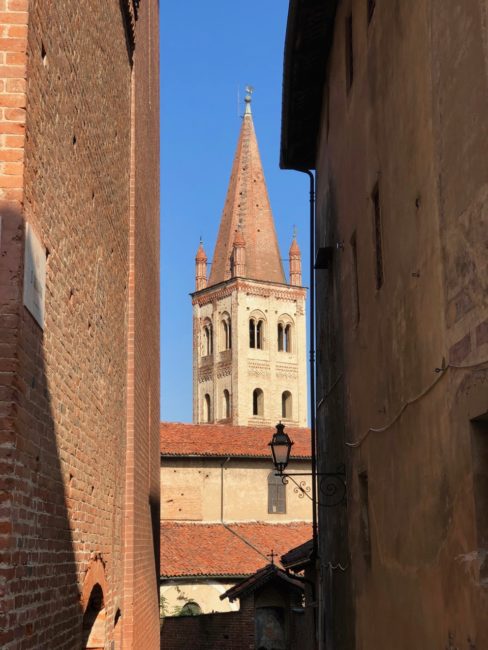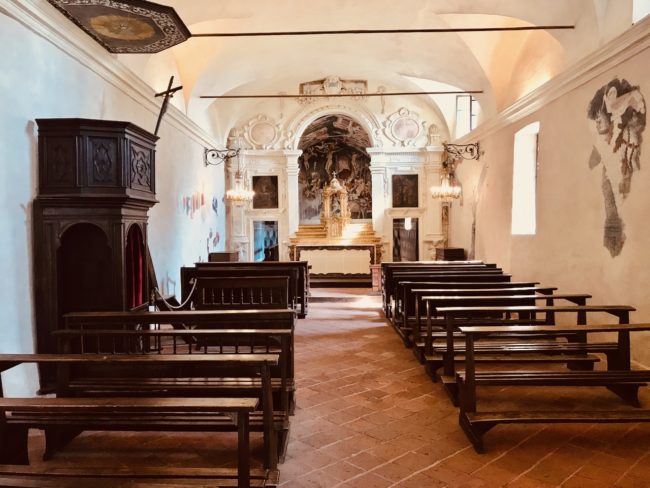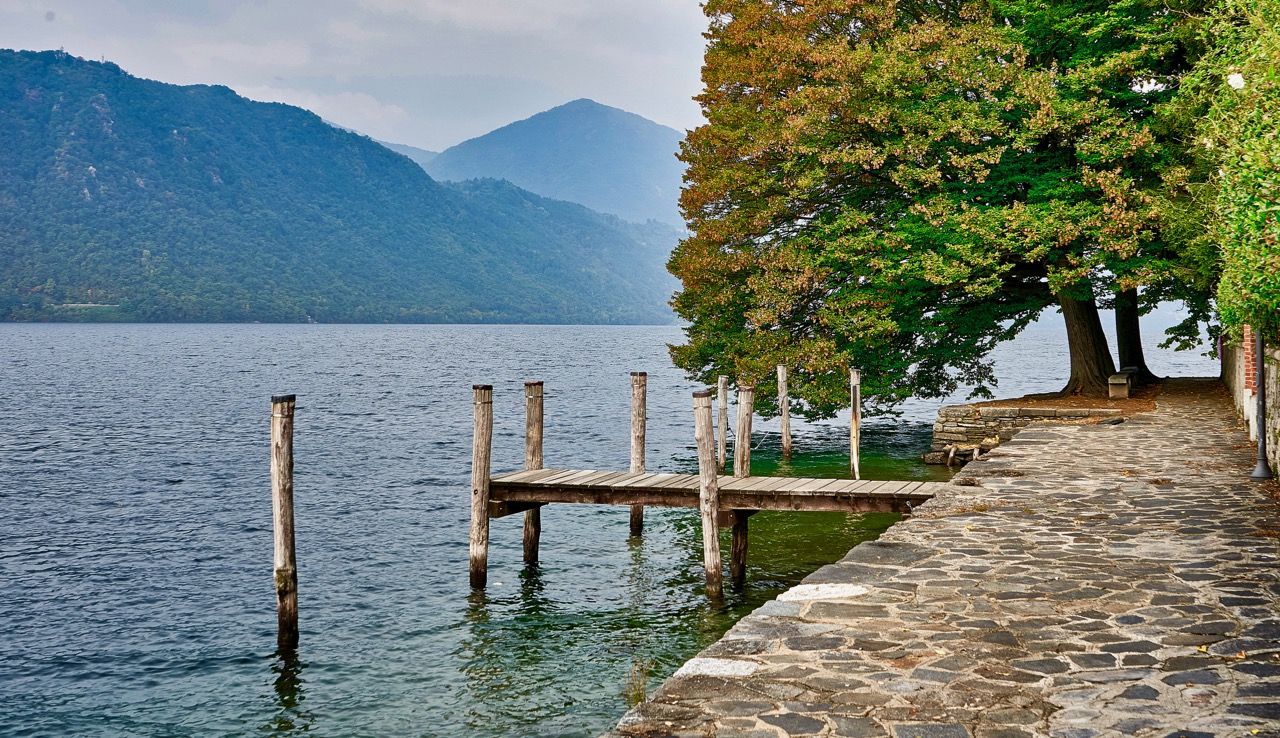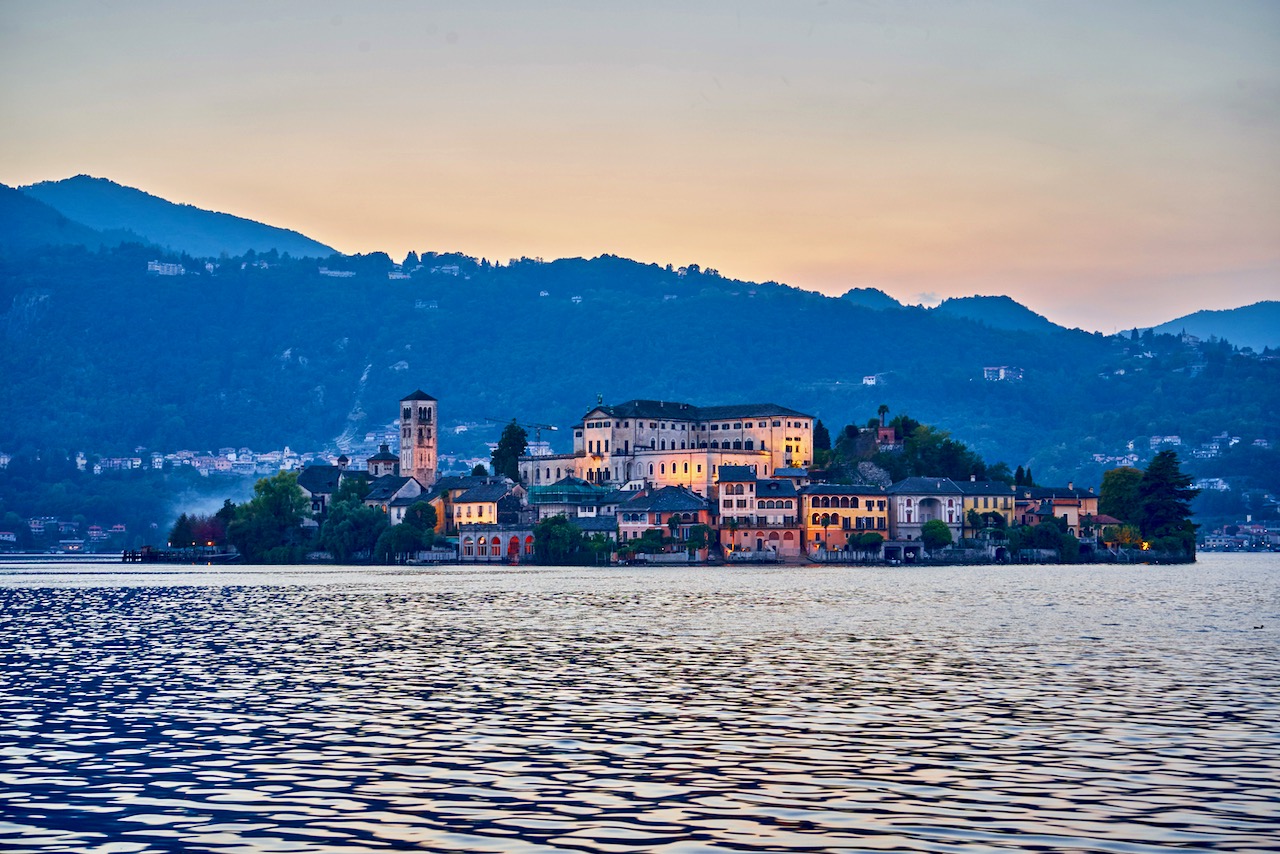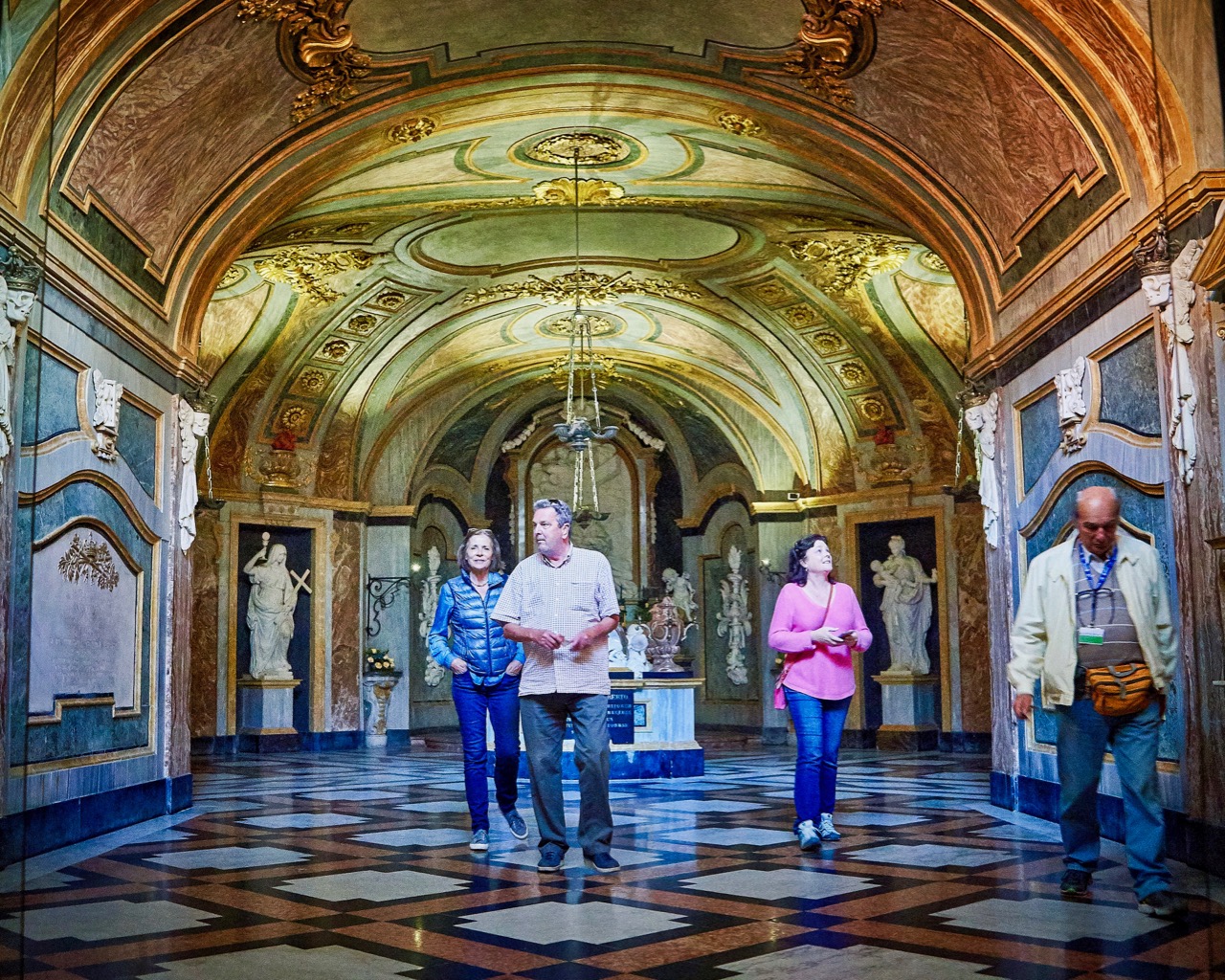
CHAPTER TWELVE – THE HILLS ARE ALIVE WITH THE SMELL OF VINO
January 7, 2019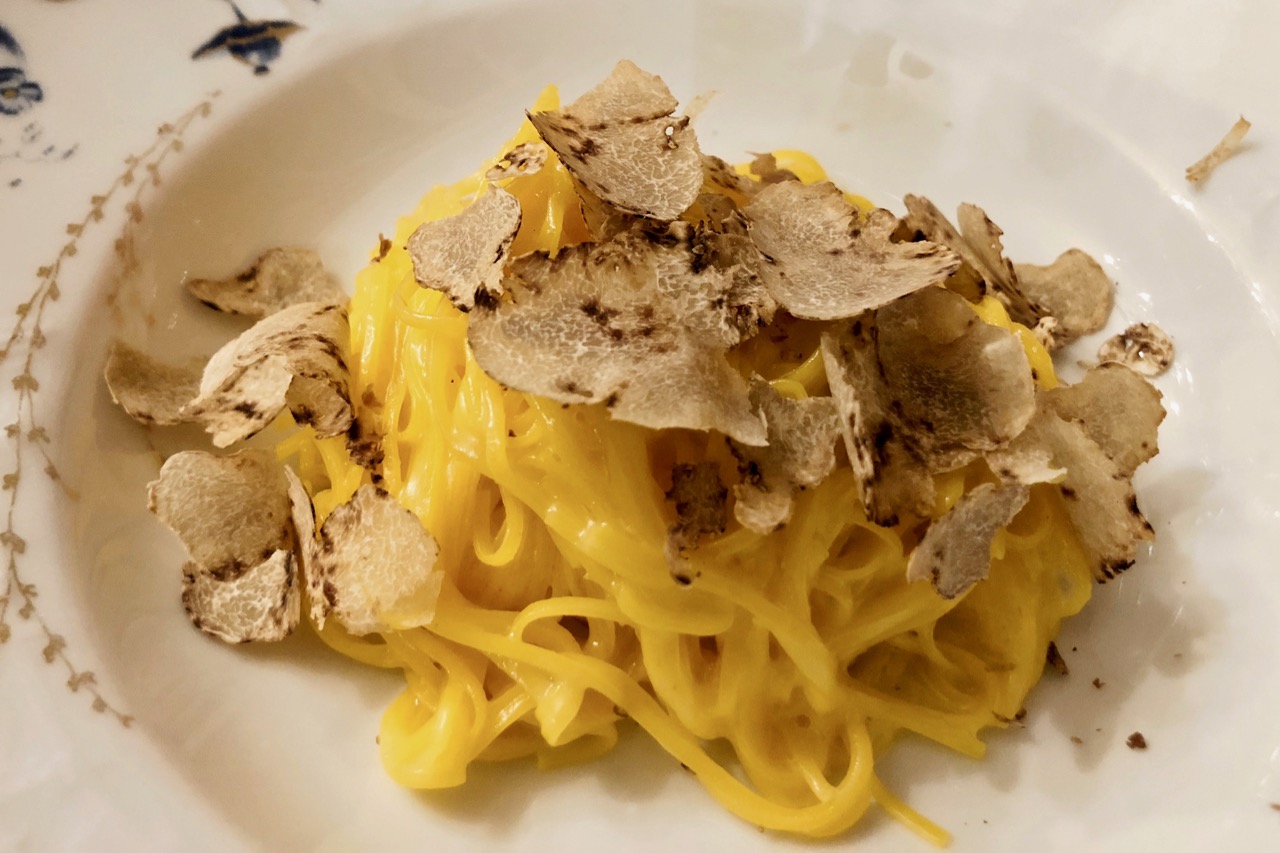
CHAPTER FOURTEEN – MAI TAI TOM’S INTERNATIONAL RESTAURANT OF THE YEAR
January 14, 2019We Still Didn’t Drink All The Vino: Mai Tai Tom’s 2018 Return To Italy
CHAPTER THIRTEEN – THE UPS AND DOWNS AND UPS OF PIEMONTE
DAY THIRTEEN – Up Up Up, Would You Like To See My Elevator?, I’m Not Going Back Up, A Slight Parking Error, “Master Of The Manta”, Exploring Fossano, Is There Anything To See Here?, This Will be Cool When It’s Finished, International Restaurant Of The Year, 40 Red Eggs and A Very Generous Umbrella Policy
It was simply another gorgeous day in Piemonte paradise. Greg and Gloria slept in to get ready for their day of wine tasting. Meanwhile, Hope, Crosby and the two Lamours were on the Road to Saluzzo, located about 40 minutes west of La Morra. Most of this 15th-century town (it was also once a powerful city-state) is still intact, and as we would find out contains some incredibly steep cobbled streets. It’s also known for its (wait for it) churches.
Not surprisingly, the first place we stepped into was Cattedrale Santa Maria Assunta, built in the late 15th century.
The first thing you notice when entering is a 15th-century wooden crucifix that hangs on the arch of the central nave. It is a large church measuring nearly 270 feet long and 69 feet wide.
Of course, it wouldn’t be a great church without a great ceiling and a great photographer (in this case, Kim).
The Chapel of the SS. Sacramento was built by Bishop Morozzo in 1729.
We visited a few of the numerous altars, like the Altare del Beato Giovenale Ancina. The altar of the Beato Ancina, erected in 1890, preserves the urn with the remains of the bishop.
Considered a masterpiece in the Chapel of the Santissimo is the16th-century polyptych depicting the “Deposition” by Hans Clemer. Since Tracy works at a law firm, she looked closely at the “Deposition.”
There is also a wooden 14th-century crucifix, and a Baroque altar by Carlo Giuseppe Plura.
We spent a rather long time seeing this church.
I tried to stay inside because I knew what was coming next, a series of steep streets up to the old town of the Margraves on the hill.
There were signs that autumn was in the air.
Although my legs attempted a revolt, I and the rest of the group finally summited the top.
Surrounded by beautiful buildings, we suddenly realized we were missing Mary. In a few moments, she exited one of the buildings. “Where were you?” we asked. “Oh, an elderly gentleman invited me into his house to show me his elevator,” she replied. I guess he really knew how to push her button, and luckily he was on the up and up.
We walked around admiring the buildings, but there was one more church in this town we had been told was well worth seeing.
Nearby was Chiesa e Convento di San Giovanni, which was built in 1325. Until the cathedral was built, it was the most important religious building in Saluzzo. The bell tower was added 50 years later.
Once again, this church differed mightily from others we had seen. You could feel yourself transported to the 14th century, well except for the other tourists.
The giant golden wooden tabernacle is hard to miss as you enter.
There are cycles of frescoes throughout depicting the Passion of Christ.
The west side opens to the Cavassa Chapel, with a portal in white marble, which is the work of the sculptor Matteo Sanmicheli. It’s decorated with frescoes dating back to the early 16th century. Also here is the tomb of Galeazzo Cavassa, who was a “general vicar of the marquisate of Saluzzo.”
This was another place we spent extra time inside admiring everything.
We briefly visited the courtyard, and found to our surprise this church is attached to the San Giovanni Resort. You can even have your wedding in the cloister.
If you go to Saluzzo, I wouldn’t miss this.
Back outside. We walked by the Torre Civica Di Saluzzo …
… and headed back (down thankfully).
I wanted to see the Museo Civico Casa Cavassa, the residence of Galeazzo Cavassa (whose tomb we had just seen) and his son Francesco. It looked like an interesting place. Unfortunately when we got back down, I checked our map and sadly realized it was located near to where we had been at the top of town. That’s when the four of us decided a bite to eat might be a better choice.
We were quickly back on the road to visit a castle located only four kilometers from Saluzzo, Castello della Manta. It is here where I made another directional error (I was on a roll). As we made our way to the castle we saw a sign for parking. It looked like we’d be the only ones visiting Castello della Manta because we were the only car parked here. Being Piemonte, there was the obligatory 10-15 minute walk up a steep path to the castle. When we reached the top, lo and hold there was another parking lot adjacent to the castle. At least my Fitbit was happy.
Constructed between the 13th and 15th centuries, Castello della Manta “gradually became a medieval stronghold in a mansion.” The grounds were spacious to say the least.
We paid our €8 (no senior discount, even for morons who parked in the wrong place) and entered. Because we hadn’t climbed enough, we went up two floors to the main kitchen with a large barrel-vaulted ceiling and huge fireplace where, for once, neither of us stood.
We then entered the vestibule that contains a painted and coffered 15th-century ceiling. It also had a 15th-century painting depicting the Virgin suckling the Child.
We the entered the coolest room in the castle. The Baronale Hall displays a dazzling cycle of frescoes that completely cover the walls.
According to literature, the frescoes are “a rare testimony of late-gothic profane painting in northern Italy.”
Nobody knows who actually painted these 15th-century frescoes, so they are attributed to the “Maestro della Manta.”
Some of the frescoes include The Nine Worthies and the Nine Worthy Women. Verses in old French are at the bottom of these frescoes that recount their deeds in history. I probably should have studied harder in high school French class.
A couple of the Worthies include Alexander The Great and Julius Caesar, while the Worthy Women are all taken from mythology, including Penthesilia, one of the Queens of the Amazons. She was killed by that heel Achilles. I don’t know which one is Pentheselia.
On the wall opposite the fireplace is a fresco of the Crucifixion with Saints John The Baptist and Saint Quentin.
Opposite the wall with all those worthy folks is The Fountain of Youth.
I wished with my aching feet I could have jumped in with them. This painting details the knight and his lover, two characters of the scene of the fountain of youth.
I think his fresco depicts the procession of the new young people after the bath in the fountain of youth. I was not among them..
We walked through the Tree Room, which I am pretty positive is really its name.
Next on the tour was the Sala Matilda Orsiri and the Camera da letto di Michele Antonio di Sallustio della Manta.
I wish there had been some information on the paintings throughout the castle.
Unfortunately I walked into the trophy room, and after seeing this poor guy, I left. Not my kind of entertainment.
There was a lovely corridor on the way to our last room, but the lighting was too weird to take a photo. Of course, that is why the internet was invented (photo below is from that esteemed technological wonder).
Finally, it was time to visit the Hall of Grotesques, which takes its name from the decorative motifs. The room is “decorated by allegorical figures and mythological scenes, an important testimony of Manneristic culture in the Saluzzese.”
The large central panel of the ceiling depicts the flaming chariot of the prophet Elijah.
What this is all about is anyone’s guess.
The views outside from the castle were pretty sweet, too.
All the staircases had a unique flair to them, and as I always do when I leave these places, I bid “Good Knight” to our host.
Before leaving the castle, we headed down to the wine cellar, but since there was no tasting, we walked to another building on the property.
Near the castle is the La Chiesa Di Santa Maria Al Castello, which had recently been restored.
It dates from the 15th century.
The chapel does not take much time to tour, and the entire castle experience was well worth our time, even with our extra hiking.
We walked back to the car, and “miracoli,” it was still the only one there.
On our drive back to La Morra, we had one more town to visit. Fossano is dominated by the 14th-century brick Castle of the Acaja family. Thanks to some nice and knowledgeable locals, they told us that we had parked in an illegal space. Fortunately there was a free parking lot situated less than 1/2 block from where I had almost got us ticketed.
Walking into town we passed by a large bronze sculpture called the Monumentom al cadre (Monument To The Fallen). It remembers the Fallen of Fossano in the First and Second World Wars.
In the distance were two cannons.
We also walked by a temporary display (ends on January 13) of a catapult designed by Leonardo da Vinci. “The Leonardesque catapult of Fossano is a special object because it does not want to be an instrument of offense, but defense” … sort of like the Baltimore Ravens.
The Cattedrale di Santa Maria e San Giovanale opened at 3 p.m., and since we were a few minutes early we wandered around town. Had the day not been so hazy, the panoramic views from a nearby terrace might have been spectacular. Instead we toured the town and took a few photos until the church opened a little before 3.
Fossano’s cathedral is dedicated to Santa Maria and San Giovenale. Constructed in last decades of the 18th century, it contains ten chapels.
Many famous Italian painters of the time added artwork.
Before the present church, there was a collegiate. It was constructed in the 15th century and enlarged in the early 1600s. Only the bell tower has survived.
It’s renowned for its annual organ concerts, and there are 17th-century paintings by Flemish painter Flemish Claret, depicting the life and miracles of the Bishop of Narni.
Back outside, we headed toward the gigantic Castello degli Acaja. This castle was a “defensive castle by Prince Filippo d’Acaia became a noble residence under the Savoy domination.” It’s also been a prison and it was utilized as a barracks, stable and warehouses for the army during World War II. We could have climbed all the way to the top for incredible views, but once again that darned haze made a climb futile, so it was time to drive back to our home base.
In La Morra, we visited Parrocchia Di San Martino, a church dedicated to La Morra’s patron saint San Martino.
This church was did not disappoint, either.
It “houses precious artistic testimonies, altarpiece, frescoes and sacred furnishings,” including Cannelli Giovanni Carlo Alberti’s masterpiece the Madonna With Child with Saint Martino and Saint Crispino.
The dome depicts the Triumph of St. Martino.
We had strayed a little ahead of Kim and Mary, since they had ducked into an art gallery. Tracy and I checked out a new panoramic terrace being constructed that will be open to the public next year and then headed back to Rocche Costamagna to get ready for our last terrace soirée.Meanwhile, since the weather in La Morra was better than the haze of Fossano, Kim and Mary decided to climb the 94 or so steps up the Torre Campanaria di La Morra.
And they have the photos to prove it. The tower, located in the belvedere square, stands at a little more than 100 feet and the views were excellent. I thanked them for taking one for my legs.
Who can argue with this?
At the appointed bewitching hour of 6:15, the six of us met on our terrace for our last round of vino, formaggio and prosciutto. Greg and Gloria had enjoyed their day of wine tasting, so why not partake in a little more.
The sky decided to save its best look for last, complete with a red hue making the skyline pop as we savored the moment.
As I’ve stated, Rocche Costamagne may be the best b&b we have ever stayed (along with Les Jardins de Loïs in Beaune and the spot we would hit in a few days in Orta San Giulio). Great hosts, wonderful ambiance and spectacular views (not to mention delicious vino) that were second to none made this a perfect lodging experience.
We had an 8 p.m. reservation at a restaurant that I had booked months in advance to ensure we’d spend our last night there. It turned out to be the best restaurant of the trip and was awarded Mai Tai Tom’s International Restaurant of 2018 (someday they will be proud of this award). It also served the most incredible pasta dish I have ever tasted, and I would come back to Piemonte just to have it again.
Unfortunately, since this chapter has gone on so long, I will have to wait until tomorrow to write about this incredible restaurant.
CHAPTER FOURTEEN – INTERNATIONAL RESTAURANT OF THE YEAR
Next (finally): Could I Get Someone To Help Me Hoist This Wine List?, 40 Red Eggs, This Is Rich, Need A Lift? and A Very Generous Umbrella Policy





















